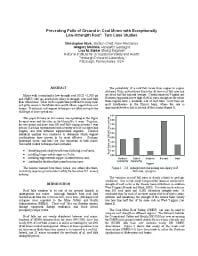Mining Publication: Preventing Falls of Ground in Coal Mines With Exceptionally Low-Strength Roof: Two Case Studies
Original creation date: August 2004
Authors: C Mark, GM Molinda, LM Burke
NIOSHTIC2 Number: 20025354
Proc 23rd Intl Conf on Ground Control in Mining, Morgantown, West Virginia, Peng SS, Mark C, Finfinger GL, Tadolini SC, Heasley KA, Khair AW, eds. August 3-5, 2004. West Virginia University, 2004 Aug; :220-227
Mines with exceptionally low-strength roof (UCS <3,500 psi and CMRR <40) are much more likely to struggle with roof falls than other mines. Weak roof is a particular problem for many room and pillar mines in the Midwestern and Northern Appalachian coal basins. Traditional roof support techniques are often not up to the challenge at these operations. This paper focuses on two mines, one operating in the Upper Freeport seam and the other in the Herrin No. 6 seam. Together, the two mines had more than 300 roof falls during a recent 5 year period. Each has experimented with a variety of roof bolt types and lengths, and with different supplemental supports. Detailed statistical analysis was conducted to determine which support combinations have proven to be most effective. Geology, horizontal stress, and time are also important at both mines. Successful control techniques have included: Identifying particularly troublesome lithologic roof units; Installing longer and stronger roof bolts; Installing supplemental support in intersections, and; Limiting the duration that a panel remains open. The lessons learned from these mines, and others like them, could help improve ground control safety for the entire U.S. mining industry.

NIOSHTIC2 Number: 20025354
Proc 23rd Intl Conf on Ground Control in Mining, Morgantown, West Virginia, Peng SS, Mark C, Finfinger GL, Tadolini SC, Heasley KA, Khair AW, eds. August 3-5, 2004. West Virginia University, 2004 Aug; :220-227
- Analysis of Roof Bolt Systems
- Design of Primary Roof Support Systems in U.S. Coal Mines Based on the Analysis of Roof Fall Rates
- Diagnosing and Controlling Moisture-Sensitive Roof in Coal Mines
- Factors Influencing Intersection Stability in U.S. Coal Mines
- The Introduction of Roof Bolting to U.S. Underground Coal Mines (1948-1960): A Cautionary Tale
- Mistakes, Misconceptions, and Key Points Regarding Secondary Roof Support Systems
- Optimizing Secondary Roof Support with the NIOSH Support Technology Optimization Program (STOP)
- Overview of Coal Mine Ground Control Issues in the Illinois Basin
- Performance Characteristics for Welded Wire Screen Used for Surface Control in Underground Coal Mines
- Preventing Injuries Caused by Unrecognized Stone Mine Roof Beam Failures With a Pro-Active Roof Control Plan